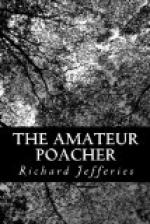The stubbles—those that still remain—are full of linnets, upon which the mouching fowler preys in the late autumn. And when at the end of January the occasional sunbeams give some faint hope of spring, he wanders through the lanes carrying a decoy bird in a darkened cage, and a few boughs of privet studded with black berries and bound round with rushes for the convenience of handling.
The female yellow-hammers, whose hues are not so brilliant as those of the male birds, seem as winter approaches to flock together, and roam the hedges and stubble fields in bevies. Where loads of corn have passed through gates the bushes often catch some straws, and the tops of the gateposts, being decayed and ragged, hold others. These are neglected while the seeds among the stubble, the charlock, and the autumn dandelion are plentiful and while the ears left by the gleaners may still be found. But in the shadowless winter days, hard and cold, each scattered straw is sought for.
A few days before the new year [1879] opened I saw a yellow-hammer attacking, in a very ingenious manner, a straw that hung pendent, the ear downwards, from the post of a windy gateway. She fluttered up from the ground, clung to the ear, and outspread her wings, keeping them rigid. The draught acted on the wings, just as the breeze does on a paper kite, and there the bird remained supported without an effort while the ear was picked. Now and then the balance was lost, but she was soon up again, and again used the wind to maintain her position. The brilliant cockbirds return in the early spring, or at least appear to do so, for the habits of birds are sometimes quite local.
It is probable that in severe and continued frost many hedgehogs die. On January 19 [1879], in the midst of the sharp weather, a hedgehog came to the door opening on the garden at night, and was taken in. Though carefully tended, the poor creature died next day: it was so weak it could scarcely roll itself into a ball. As the vital heat declined the fleas deserted their host and issued from among the spines. In February, unless it be a mild season, the mounds are still bare; and then under the bushes the ground may be sometimes seen strewn with bulbous roots, apparently of the blue-bell, lying thickly together and entirely exposed.




